NBA superstars LeBron James, Grant Hill, and Shaquille O’Neal have all endorsed cryotherapy.
But do you know why?
If not, it’s time to delve deeper. This therapy releases a happy hormone, dopamine. But there’s more to Cryotherapy’s popularity than a refreshing spa experience.
It goes beyond just a boost of happy hormones. Interestingly, It’s being used to treat serious conditions like bone cancer, cervical cancer, and liver cancer.
Its popularity is on the rise in India, too.
So, let’s learn about the world of cryotherapy and how it’s revolutionizing the Indian wellness landscape!
What is cryotherapy?
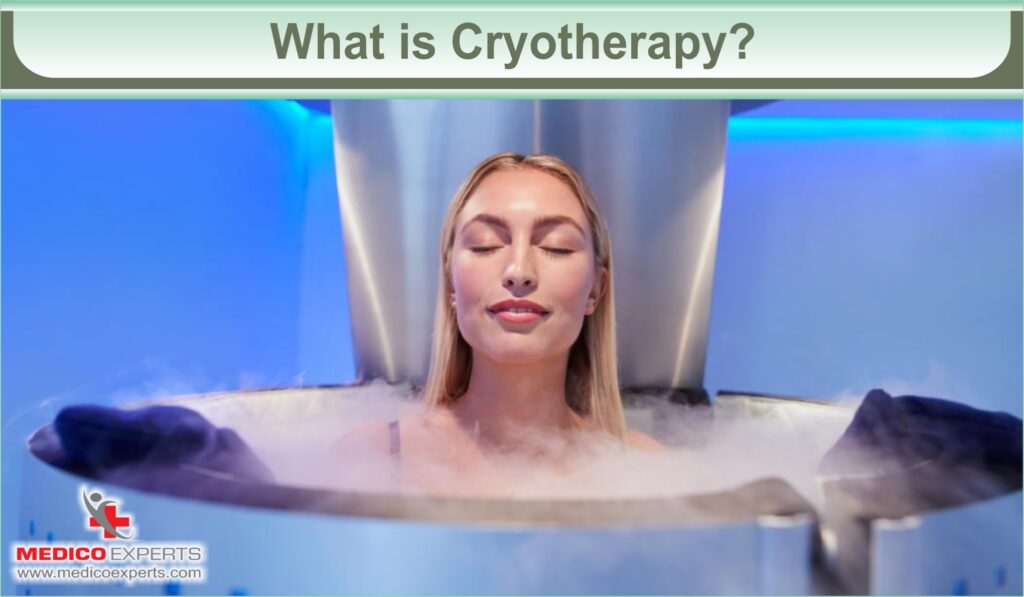
Cryotherapy is a medical procedure in which abnormal tissue is eliminated using extremely low temperatures. It is one of the oldest ways to treat injuries.
Healthcare professionals employ substances like liquid nitrogen or argon gas to induce this intense cold, effectively freezing and destroying the targeted tissue.
Health care specialists use this procedure to treat various skin disorders and certain types of cancers such as prostate and liver cancer. The technique is versatile and can treat both external skin tissues and internal bodily structures. It is also commonly known as cryoablation.
Now that you know what is cryotherapy, you might be curious to know what are its uses. Let’s go a bit deeper into the matter to understand that.
What are its uses?
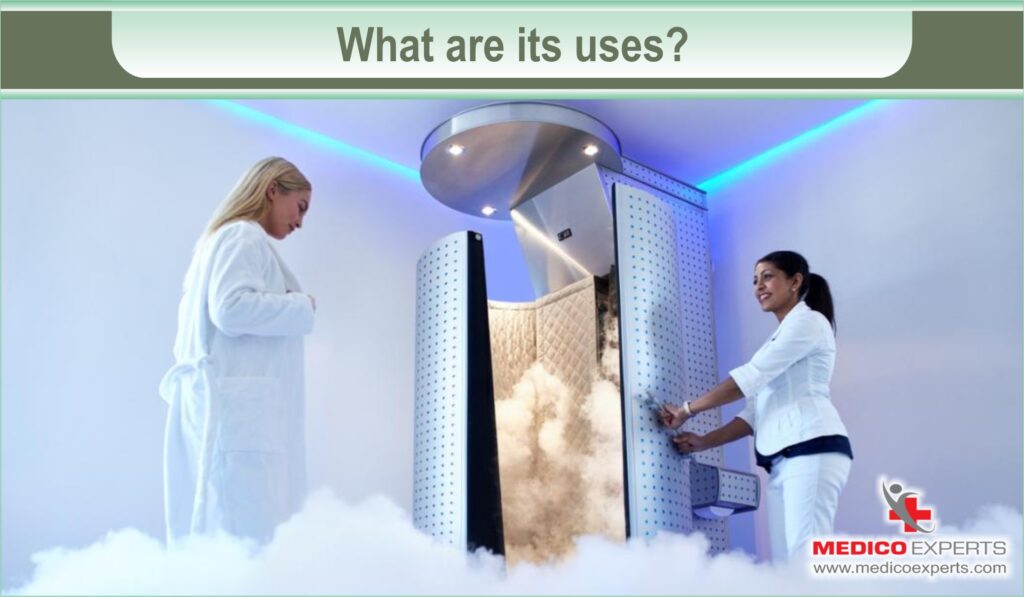
Cryotherapy represents a minimally invasive therapeutic approach that targets and eliminates compromised or diseased tissue stemming from different medical issues.
The best part is this treatment method typically avoids the need for traditional open surgery. Also, the recovery process following cryotherapy is often swift and relatively painless.
Healthcare professionals might suggest cryotherapy for the following conditions:
- Cervical cancer, liver cancer, or prostate cancer
- Precancerous cervical cells (located at the lower part of the uterus)
- Precancerous skin conditions and initial stages of skin cancers like squamous
- Bone cancer
- cell carcinoma (cancer that forms in epithelial tissue) and basal cell carcinoma (skin cancer that forms in sun-exposed areas).
- Retinoblastoma (a type of childhood retinal cancer).
- Painful joints in your body (using a cryotherapy wand)
- Skin issues such as warts, skin tags, or pigmentation irregularities.
- To rejuvenate skin (non-medical treatment in a spa or similar setting)
Here we are going to focus on the medical use of cryotherapy.
What are the benefits of cryotherapy?
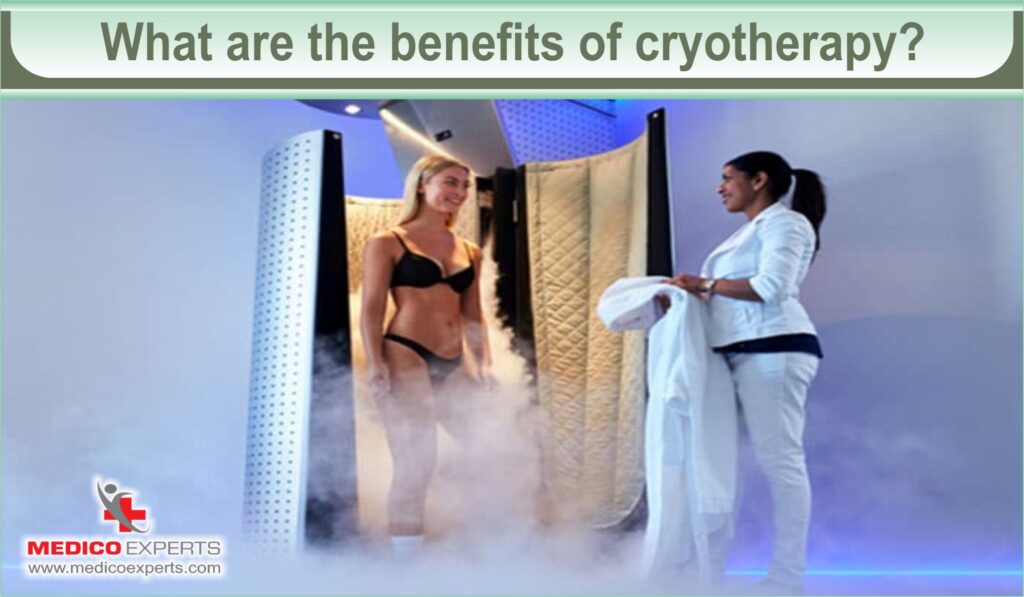
The benefits of this amazing treatment method are:
1. Muscle healing and pain relief
Cryotherapy can help you manage muscle discomfort and get relief from certain joint and muscle conditions like arthritis.
What’s more, medical professionals have advocated the application of cold packs to injured or achy muscles. This practice can enhance blood circulation upon removing the cold pack, ultimately fostering pain alleviation and healing.
A study conducted in 2000 showed that cryotherapy provided temporary relief from rheumatoid arthritis pain. This research indicated that using ice packs in cryotherapy could reduce the adverse effects of strenuous exercise, leading to decreased pain levels.
A 2015 Cochrane Review analyzed four studies on cryotherapy for muscle pain relief and identified no significant discernible benefits.
Another study confirmed the advantages of cryotherapy in easing muscle discomfort and expediting the healing process. However, it highlighted that cold water is much better compared to whole-body cryotherapy.
2. Preventing cancer
Due to its potential to decrease inflammation, whole-body cryotherapy has raised the possibility of lowering the chances of cancer onset.
Although there is no evidence that cryotherapy can treat cancer once the cancer cells develop, medical professionals widely recognize cryotherapy as an established approach for specific types of cancer.
In the medical realm, cryotherapy is employed by doctors to freeze cancer cells located on the skin or cervix, and in certain cases, for the removal of other cancerous growths.
3. To improve eczema symptoms
Eczema, a persistent inflammatory skin condition, can result in highly itchy patches of dry skin. Cryotherapy helps improve the symptoms of this condition
In a research conducted in 2008 involving individuals with eczema, the participants discontinued their use of eczema medications and instead experimented with cryotherapy. A considerable number of participants noted improvement in their eczema symptoms.
However, a few reported experiencing frostbite on localized skin areas.
4. Treatment of migraines
According to a study targeted cryotherapy that focuses on your neck may help prevent headaches triggered by migraines. The study also indicated that the treatment reduced the pain but didn’t eliminate it completely.
5. Lowering inflammation
Inflammation is your immune system’s way to fight infection. But sometimes your immune system becomes overactive and it results in chronic inflammation. Chronic inflammation, on the other hand, may result in cancer, diabetes, dementia, depression, and arthritis.
Cryotherapy makes your body’s surface temperature drop causing your blood vessels to constrict and then delate. This results in an increased flow of oxygen-rich blood to the tissues. The process can help lower inflammation, boost circulation, and improve your immune system.
6. Gynecological treatments
Cryotherapy is also used in gynecological treatments. It is used to freeze and destroy damaged and abnormal tissues in and around the cervix.
Now let’s move on to understand the procedure of this therapy.
How does this method work?
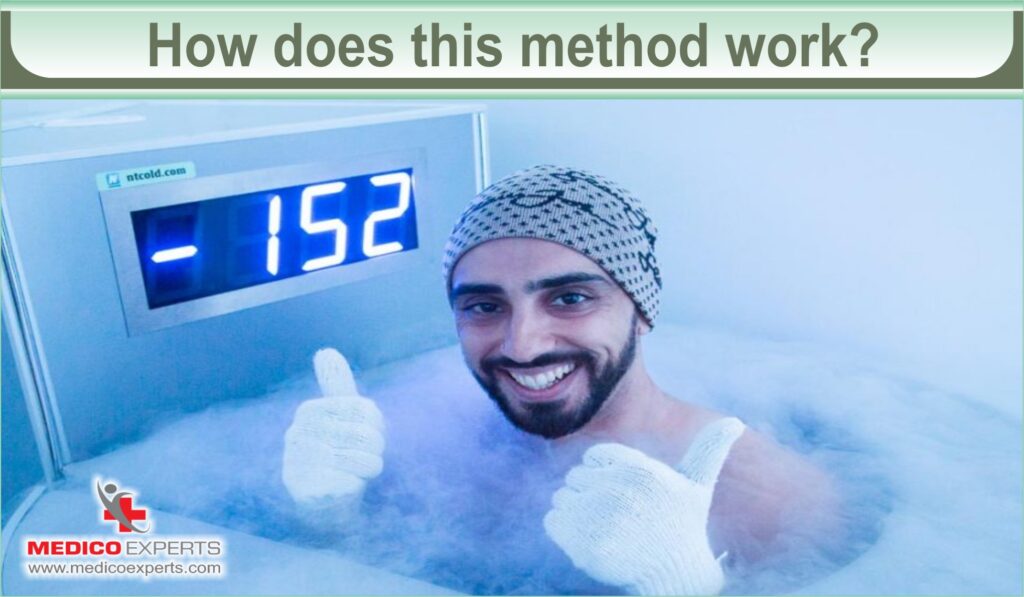
By now you must have understood that during cryotherapy, doctors use extreme cold to treat abnormal tissues. But let us help you understand, how it works.
Substances to create extreme cold
Your healthcare provider may use different substances during cryotherapy. Some of them are:
- Liquid nitrogen
- Liquid nitrous oxide
- Argon Gas
Different cryotherapy methods
Your healthcare provider may use different cryotherapy methods depending on the location of abnormal tissues.
External location
If abnormal tissues are located on your skin, the doctor will more likely use a spraying device or cotton swab to apply the cooling agent.
Internal Location
To treat precancerous cells and tumors, the doctor will use a device called a cryoprobe. This device is inserted into your skin through a small cut.
How to prepare for the procedure
Typically, you need to do nothing as preparation before cryotherapy. But in the case of internal cryotherapy, your doctor will give you some instructions.
The doctor may ask you to
- Stop taking certain medications like aspirins or blood thinners a few days before the internal cryotherapy.
- Limit your food and drinks before the surgery
What exactly happens during the procedure
Here’s what happens during cryotherapy:
External Cryotherapy
As said above, in external cryotherapy, the doctors will apply the cold with a spray device or a cotton swab. They typically use liquid nitrogen for the procedure.
Internal Cryotherapy
Doctors will insert the cryoprobe into your skin through a tiny incision. To guide the device, they might use ultrasound imaging. You may be given local or general anesthesia depending on the location of the abnormal tissues. Local anesthesia will numb the exact spot where it is used while general anesthesia will make you sleep.
What happens after the therapy
In the case of external cryotherapy, the treated area may turn red or you may have blisters. You may also feel mild pain which will go away within two to three days. A dry rough protective crust, also known as a scab will form in the treated area and that will go away within three weeks.
Those who undergo internal cryotherapy may feel pain and soreness in the treated area which will go away in two or three days. Women who undergo this therapy in the cervix might have water discharge for a few days.
What are the side effects of cryotherapy?
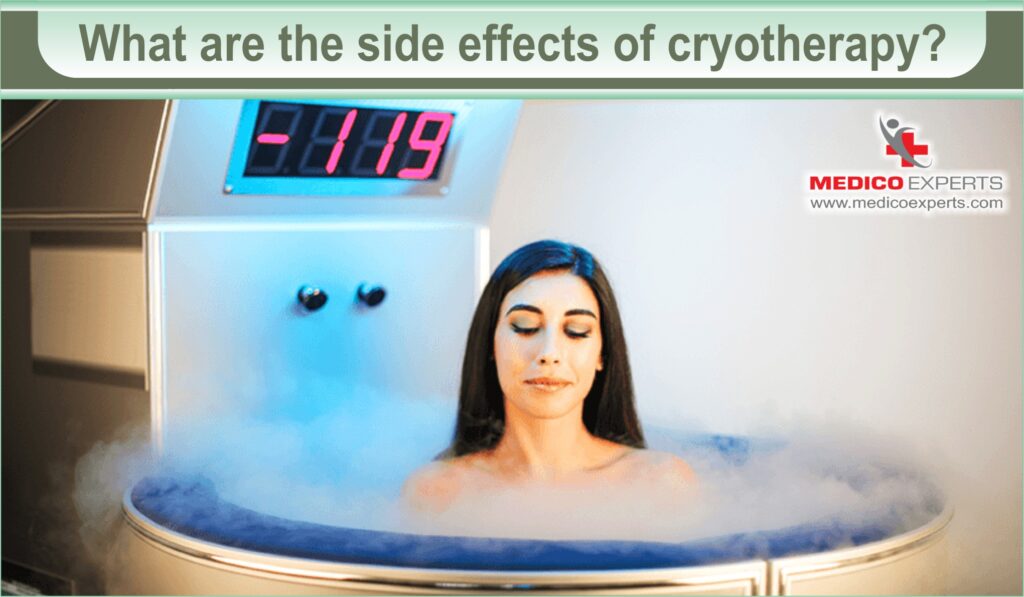
This minimally invasive procedure has a low risk of damaging your healthy tissues, But it, too, has side effects. Here are some of them:
- Bone fracture
- Bleeding and pain if you have this procedure around your cervix.
- Swelling
- Scarring
- Skin infections
- Loss of feeling due to nerve damage
If the side effects persist even after 3 weeks, you should consult your healthcare provider.
Is cryotherapy available in India?
For people across the globe, India has become the hub of medical tourism. MedicoExperts has also joined its mission in India to provide good health to people across the world with the best treatment facilities at a very reasonable cost.
This procedure is done in some of the top hospitals in Mumbai, Delhi, Bangalore, Chennai, and many other cities.
What is the cost of cryotherapy in India?
The cost of cryotherapy is around 4,200 INR per session in India. The cost of treatment varies depending on the following factors:
- Hospital standards and location
- Experience of the surgeon
- Choice of accommodation
- Room category
- Additional complications and evaluations
Final thoughts
Before opting for this treatment method, do your research well. There is nothing better than making an informed decision.
MedicoExperts has an expert panel of doctors who would help you get the best medical services at a very reasonable rate. Our team will also make sure that you get all the attention and care you need before and after the procedure.
Avail our services and get the best-in-class medical care without burning a hole in your pocket.
FAQ :
Q1. Is cryotherapy safe?
Although this procedure is non-invasive and safe, whole-body cryotherapy may have side effects such as frostbite, frozen limbs, and rashes.
Q2. Is cryotherapy painful?
Though this procedure doesn’t hurt, the exposure to the cold creates a strange sensation during the cryotherapy sessions.
Q3. Does cryotherapy lighten skin?
As per some experts, cryotherapy can lighten skin.
Q4. What is the success rate of cryotherapy?
The success rate of biochemical progression-free survival for low-risk patients is 96.4% with cryotherapy.
References
https://pubmed.ncbi.nlm.nih.gov/10832164/
https://www.ncbi.nlm.nih.gov/pmc/articles/PMC3727573/
https://www.ncbi.nlm.nih.gov/pmc/articles/PMC8899563/
https://www.ncbi.nlm.nih.gov/pmc/articles/PMC1472868/



